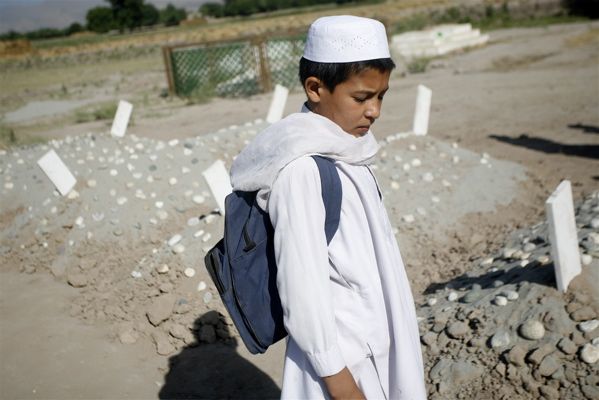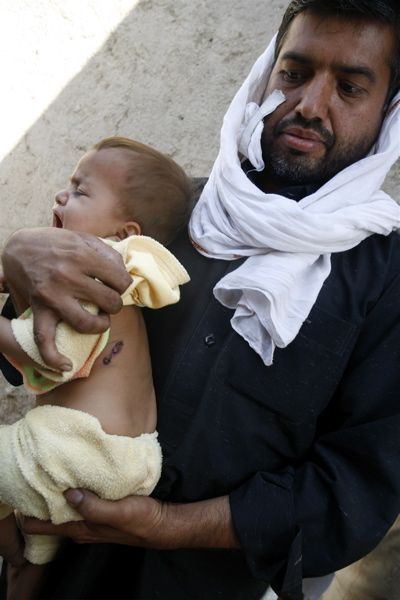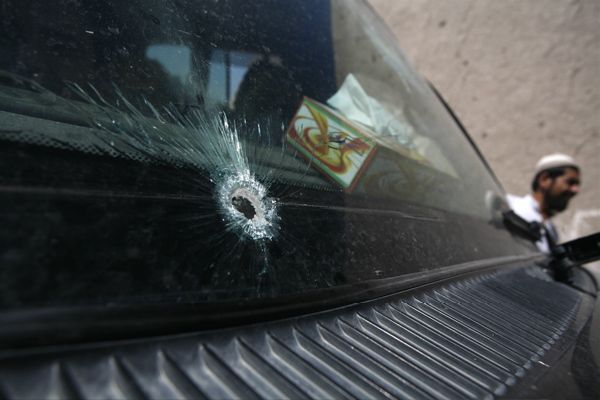Jason Motlagh, for the Pulitzer Center
Jalalabad, Afghanistan
It was late Friday afternoon when we heard that a nighttime US Special Forces raid had allegedly killed civilians in a village about nine miles west of Jalalabad, our reporting base in eastern Afghanistan's Nangarhar province. Our local fixer had waited to pass the news; he feared that we'd insist on going straight to the scene where a brick-throwing mob might have attacked us once they learned we were American journalists. He was right.
Wire reports based on witness accounts were saying that at least ten civilians were killed: nine in the raid, and one shot dead by police when protesters tried to break into the district headquarters. The US military maintained the operation had targeted Taliban militants, including a sub-commander by the name of Qari Shamshudin who was killed. It said no civilians were harmed.
Under Gen. Stanley McChrystal, the commander of international forces with a special operations background, night raids have accelerated to undercut the insurgency's leadership structure. They are part of the gathering offensive to re-assert control over the ethnic-Pashtun heartlands where the Taliban is strongest. Ground forces must adhere to new restrictions meant to reduce civilian casualties that have eroded public trust. But Special Forces continue to operate freely outside the chain of command. The secretive nature of missions, and the fact they typically happen in hostile areas, have made them difficult to report on. This was a rare chance to follow-up.
We drove past the district police center, where the day before protesters had chanted "Death to America" and the unpopular provincial governor, Gul Agha Shirzai. Shopkeepers were now opening their stalls. A police officer peered out from the broken window of a guard tower that loomed over the road, charred from burnt tires. Coils of razor wire had been torn off the perimeter walls.
Before reaching the village of Koshkaky, scene of the raid, we pulled off at a crumbling cemetery on the side of the road. In the near-distance, a group of women in sky-blue burqas crouched around five fresh mounds of dirt topped with stones and pale white stakes. Torn green flags, the color of Islam, rippled in the desert wind. Then, silently, they walked away. A small crowd of young men replaced them.
The graves belonged to a family of five -- a father and his four sons -- said 19-year-old Assadullah, a student who lives in the area. He knew the boys well, he added, and listed their names and ages one by one. He and his friends said they had no knowledge of any Qari Shamshudin, the alleged Taliban sub-commander. They said their village was peaceful, free of militants. "(The Americans) killed innocent people. We know the truth because we are from this village," he said. "They are more dangerous than the Taliban." One boy who stood outside the group held a hard stare while I interviewed the others.
Koshkaky was quiet when we arrived, the sun pounding down. A few men greeted us outside the high adobe walls of the communal compound where the American assault took place. They seemed to be almost emptied of anger, perhaps spent from protesting and mourning. Nazir Ahmad, a burly farmer with a bandaged face, shook our hands and gave his version of what happened, explaining how he was awakened by gunfire and thought that thieves were on the property. It seemed to be coming from the guardhouse outside the walls. He claims that he and several other men picked up rifles and fired warning shots into the air, only to be struck down by a hail of bullets and grenades. (The US military says forces issued a warning and were fired upon.)
He said his brother-in-law, Sayid Rahim, was killed within seconds, along with his sons. Nazir was comparatively lucky: he took a piece of shrapnel in his cheek. His daughter was hit in the back. On seeing this, he says, "all I could think about was putting on a suicide jacket."
Our attempts to get inside the compound to assess the damage were futile; we were told women were still mourning inside. Its front door was partially blown off its hinges; faint pools of dried blood and shattered glass were on the ground, and a few car windows were smashed by bullets. The bodies of the deceased, however, were already underground in accord with Islamic custom.
Nazir said that US forces and Afghan forces had detained them until after dawn. They were interrogated for several hours, he went on, while some soldiers cleaned up the scene and tended to the wounded. Their weapons were taken away, as well their cell phones. In a statement released to the media, the military used the term "communications equipment."
At the guardhouse where villagers say the shooting began, the blood-stained sheets and pillows. There was no trace of the dead inhabitants, Gholaleh and Babar, save for a picture of one of them on the wall posing with friends by a rickshaw. A poster of Haji Qadir, a former government minister from the area who was assassinated, hung beside it. One of our escorts said this was proof the guards were not militants. "If the Taliban saw this poster, they would kill them for sure."
Our hosts said it was time to leave. They offered no reason why, though it appeared that a group of elderly men sitting outside might have been bothered by the presence of American journalists hours after American soldiers had stormed in and killed their own. So we left, without any sense of feeling threatened. For all we could tell this was not a hostile place. But our first-hand impressions that something had gone wrong lacked the ballast of hard evidence. There were just fragments.
As usual it was a case of "our-word-versus-theirs", Afghans and the US military telling two different stories that could not be reconciled. One thing was certain, though: this village was lost.





